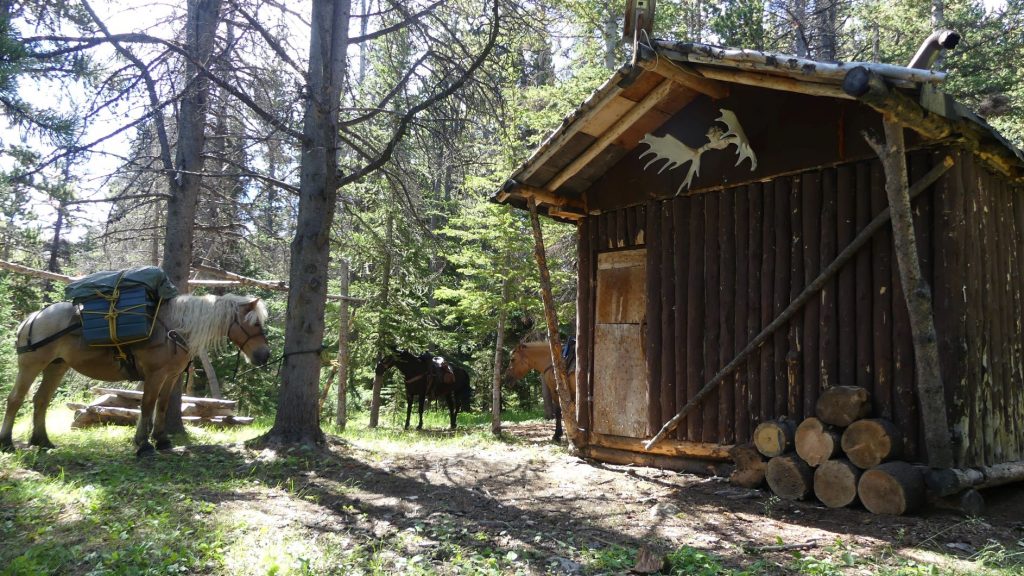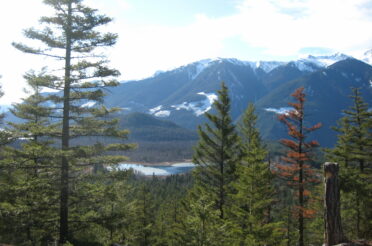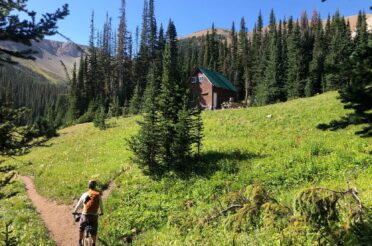Big Creek Camp

Summary: Big Creek camp is for the advanced hiker or rider, you’ll need to be well prepared to journey to this camp. This story will introduce you to the mountains, wildlife and experiences around Big Creek camp.
A trip to Big Creek isn’t for the faint of heart. Of our twenty-five wilderness cabins, it is one of the most remote and that means that the mountain energy is stronger here. A ninety minute drive to the trail head and then an eight hour ride to camp. This isn’t a camp with easy access back to civilization if you decide you aren’t up for the challenge. So come prepared. Bring all the food you need and some extra, just in case you’re stranded by a blizzard (we get snow in every month) or a mud slide. Pack all the layers of clothing you think you need, then pack a few more. Take your best horses, you’ll want them to be calm, stable and reliable as you venture deeper into the wilderness than you’ve ever been before.
This is the mindset we began our trip to Big Creek with, Kevan and I are the guides, leading our three guests into the wilderness. Anna, Sue and Chrissie have been friends since high school. They’ve ridden with us three times before, have lots of experience with horses and are ready for the next step of their journey.
We start early, nine and a half hours of travel time ahead of us. The pack boxes are packed in the trunk of the truck. The horses are in the trailer. We’re appreciative in the early morning sun for experienced horses, practically loading themselves into the trailer. Anna, Sue and Chrissie are riding Meg, Billy and Steel. As experienced riders, our guests could tell within seconds of meeting them that these are calm, stable and reliable horses. Kevan is leading the ride with Jack, who is ready to hit the trail and set the pace. I am riding Blue and leading our pack horse, Sorcerer.
Anna, Sue and Chrissie’s excitement is palpable. They’ve been to three of our other camps before which means they have some idea of the experiences they will have and the horses’ capabilities. But each camp always gives the opportunity for different landscapes, difference species, different terrain. They’d be excited to do this alone, but to be doing it with each other and with their horses makes it even more special, it will be a bonding and learning experience.
We begin the long ride into Big Creek, through the forest, the horses knowing how to avoid the muddiest patches. When we break out of the trees, we can see Castle Peak, a distinctive pyramid-like structure the result of an ancient volcano. Our guests have seen the other side of Castle Peak once before. Then it was an indistinct purple-orange triangle in the distance as they took a lunch break on top of Spruce Peak when they stayed at our Eldorado Camp. They now feel the thrill of seeing it so close up, knowing they are venturing further north, deeper into the wilderness. This is a nature connection, piecing together the South Chilcotin Mountains, how did each mountain range and valley fit together?
In the early afternoon, we break through the tree line, we are riding over sandy shale, traversing the slope, tiny grey and rust-coloured rocks roll and bounce down to the valley bottom, reminding us all how far up we are. It is a long way to fall, but our sure-footed horses mean we never feel worried about that. Relay Mountain is to our right. Is that white dot a mountain goat or a mountain rock? Our guests have seen a whole herd of goats ranging across Spruce Peak at Eldorado, they know how easy it is to mistake a rock for a goat. So we get out our binoculars to make sure. It is a goat! A lone billy resting on a seemingly vertical cliff face. He looks right at us, we know he can smell and hear us better than he can see us, but he is for sure aware of our presence.
On we ride, skirting more mountains and in what seems like no time we are at Elbow Pass. This is another thrill for our guests as we pass into Big Creek Provincial Park. This is the first time they journeyed beyond the South Chilcotin Mountains Provincial Park with us. We are close to camp now. We get off and walk the horses down the rocky mountain slope, back below tree line and we come to the shores of Big Creek. This is one of the biggest creeks in our area, the white-grey rocks on either side make a beach. These rocks are this colour because of glacial till, the erosion of material as glacial ice moves, this eroded material is deposited down river, in this case around Big Creek and the nearby Grant Creek. Big Creek is wide but shallow. The horses have no trouble crossing. I remind our guests to look behind them at Dorrie Peak and Iron Pass. It’s a spectacular view, every time it takes my breath away and our guests feel the same. Next up is a swampy meadow. The horses seem to know instinctively where to put their feet so they don’t sink in. And now we weave through the forest until the hitching posts and saddle rack appear through the trees.
The horses have sure earned their oats. Our three guests unsaddle the riding horses while Kevan and I take Sorcerer up to the cabin to take her pack boxes off. We come back and find all the saddles on the saddle rack. They’ve done this before and really appreciate that they are able to be “hands on” with their pack trips. For the first few days we plan to stake close to the cabin so we lead the horses out and stake them. Our guests have staked their horses before and with a quick reminder, we make an efficient team, staking five of the horses and hobbling Sorcerer who bunny hops around her tied herd mates as we walk back to camp.
We assign tents and make a campfire for dinner. Everyone gets involved, the BBQ ribs and baked potatoes are a big success. After a long day’s riding, we’re ready to call it quits. Wood-framed canvas wall tents, a soft foamie and warm sleeping bag are all we need to make our beds.
The next morning we’re up early. Our first job is to bring in the horses. The guests need almost no instruction from us as we pull out stakes, untie knots and lead our horses back to the hitching posts. We give them oats and saddle them before breakfast. We cook bacon, eggs and toast on the campfire again. The weather is warm and sunny, we’ve hardly been in the cabin yet. It’s an old vertical log cabin with three layers of sleeping area at the back. There’s a propane stove and a wood-burning stove. The window is small to stop grizzly bears getting in but it also restricts the light getting in. It’s the perfect place to shelter from the wind and rain on a cold evening, but on a warm morning, we just want to be outside.
After a long ride yesterday, we all agree on a shorter ride today. We ride to Lorna Lake. The water is a mystical green-blue, it’s glacier fed which is what gives it that colour and there’s a certain energy to it, something that draws us to it, makes us feel calm and peaceful.
The next day, we ride to Iron Pass, where we crest the top to be greeted with stunning panoramas. Our horses walked up to the pass on small yellow, brown and grey rocks and now we stand on rocks coated with an iron-ore dust. But immediately around us are mountains in grey, green, orange, purple and black. Anna, Sue and Chrissie have never seen a purple mountain before, they are awestruck and they are feeling the energy of these mountains again. It’s September, but there are still snow banks from last winter. These will never melt, every month of the year there is some snow on these mountains. And in the distance, the mountains are blue and white, blending into the horizon, jagged rocky tops in every direction, as far as the eye can see. To the west there are the Coastal Mountains. These are much younger in evolutionary time, it makes their tops sharper unlike the older, rounded tops of the Chilcotins. The contrast, as much as the variety of colours is what makes this view so special.
The rest of our week is made up with one spectacular view after another. We ride along the fertile slopes of Grant Valley, around the end of the rocky Cluckata Ridge and into Tosh Valley where willows grow around Tosh Creek but dry rocks compose the side of the valley. We look down towards the creek – staying high so we can traverse around the valley – and see a grizzly sow and four cubs. In other parts of the world, grizzlies have one or two cubs. But here, it’s not unusual to see them with three or four. Why? What’s so special about this area? Well, this area is unique for a lot of reasons but in this case, it is because of a tree called the white bark pine.
Every three years this tree, identified by its grey-white bark and needles that grow in groups of five, produces its pine cones. The bears eat the cones whole to get to the pine nuts which provide so much protein, sows have enough fat when they go into hibernation to support the development of three or four cubs. We share this information with Anna, Sue and Chrissie. They’ve heard this story before, we share it on every trip, but this is the first time they’ve seen the evidence of that extra protein. They take pictures until the bears amble out of sight, not at all worried by our presence.
Once the bears are gone, I get out the Wildlife Sightings Form from my saddle bag and we get off our horses so Anna, Sue and Chrissie can contribute to conservation. Every time we see wildlife we record as many details as we can so we can build up a detailed picture of how many animals there are and where. Grizzlies are particularly easy to do this with as they are so distinctive – grizzlies aren’t all brown, some are black, blond, silver-backed, cinnamon. And when your throw a few cubs into the equation, you have a very unique group of bears to identify. Our guests are very enthusiastic about getting involved. Every time they visit the South Chilcotin Mountains they strengthen their emotional and spiritual connection to the place and become more determined to conserve it. We know the best way to get people interested in conserving an area is to give them the opportunity to love it first. Anna, Sue and Chrissie sure love it and want to preserve it because, they tell us, they want their children and future grandchildren to still have wilderness places to visit in an increasingly urbanized world.
Still buzzing from the encounter with the sow and four cubs, we continue traversing around Tosh Valley and with some technical uphill riding over shale rocks and sand, we make it to the top. This is the Dil-Dil Plateau. This marks the transition from the Chilcotin Mountain to the Chilcotin Plateau. Like Castle Peak, Anna, Sue and Chrissie have caught a glimpse of the Dil-Dil Plateau from Spruce Peak. They can’t quite believe they are now standing on top of it. Just poking out from behind another mountain is a dark brown stubby mountain. When Chrissie asks its name, Kevan says that’s Ram Mountain and just below it, hidden behind the mountains is Nadila Lake. This sparks their interest and Kevan suggests we ride there tomorrow. It’s a long way, but everyone is up for the challenge.
So we walk our horses back down the slope, retrace our steps around Tosh Valley, over the Cluckata Ridge and along Grant Valley. The next day we get an early start and put the hustle on – we don’t want to be riding back to camp in the dark this evening.
We all know the way to the Dil-Dil Plateau now and this familiarity with the way only seems to increase our excitement to journey further. After the Dil-Dil Plateau, we walk down into the valley, back up to the next mountain, down once more and finally we reached Ram Mountain. We still wanted to see Nadila Lake so we kept up the pace. Nadila Lake is truly a special place, located above tree line, it’s glacier fed giving it that same turquoise colour as Lorna Lake. It’s surrounded by willows and a real favourite place for moose. Our guests really want to see one so we agree to wait a few minutes before heading back to camp. None of us can quite believe it when a huge bull moose appears from behind the willows to feed on the slope. Moose need low browse so this area is the perfect habitat for them. He must have smelled us because he turns his head towards us. Our guests are mesmerized. I am too, it isn’t every day you see a moose, even here in the wilderness.
With our energy high, we ride back to camp, keeping up a good pace. As we ride, Kevan tells our guests about the old trapper’s cabins in Tosh Valley and the trapper’s lifestyle. They all want to see these cabins so we plan to visit two the next day. The roof of the first is collapsed, the logs faded and dull. The door is only 5ft tall, we can see over the tops of the walls. Inside the cabin, the weeds grow high. Nature is starting to reclaim this cabin.
But the next cabin is totally preserved. The square logs have been cut by hand with an axe. The roof is a sod roof, mud with grass growing on top effectively waterproofing this cabin in a dry climate. Unusually, the wood stove is at the back of this cabin. Normally the stove is beside the door where the cold air comes in and is quickly redirected into the stove. Like the Big Creek cabin, it has a small window to stop bears getting in. Although we don’t see them, the cabin is currently occupied by a family of pack rats, we can tell by the smell. Kevan tells our guests pack rats are “real cute, but real smelly”. The smell doesn’t bother us. Our guests are captivated, standing inside a piece of history, a rustic, 100 year old tribute to a fading lifestyle.
This concluded our trip to Big Creek. Anna, Sue and Chrissie don’t stop talking as we ride back to the Paradise Trail Head. They are now very familiar with our Three Pillar philosophy and explain to us how they experienced each pillar on this trip. They explain that every second was a nature connection, from seeing familiar mountains from a different perspective, exploring new territory, seeing all the wildlife and cooking on the campfire. Personal development was facilitated as they practised their horse care skills. And they contributed to conservation by filling in the Wildlife Sightings Forms and choosing an eco-tour instead of a less sustainable vacation. Anna, Sue and Chrissie are all guides-in-the-making. We’re looking forward to our next wilderness experience with them.
Charlie



